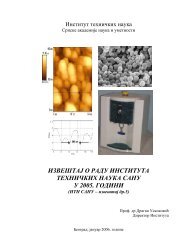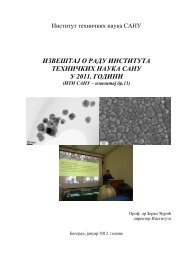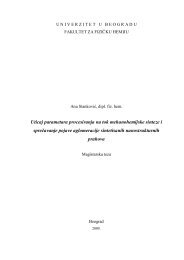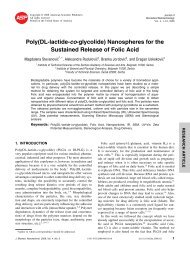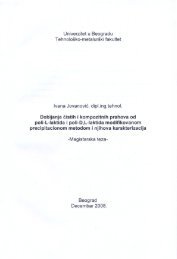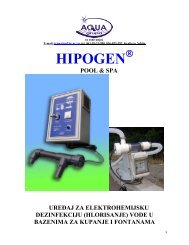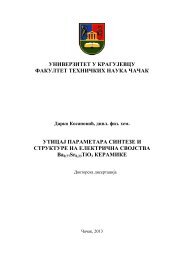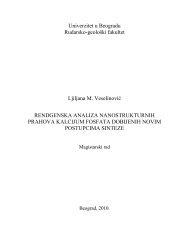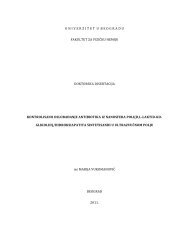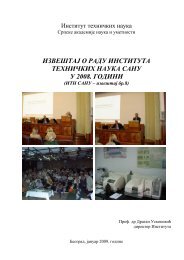Program and the Book of Abstracts (PDF) - Mrs-serbia.org.rs
Program and the Book of Abstracts (PDF) - Mrs-serbia.org.rs
Program and the Book of Abstracts (PDF) - Mrs-serbia.org.rs
You also want an ePaper? Increase the reach of your titles
YUMPU automatically turns print PDFs into web optimized ePapers that Google loves.
Tenth Young Researche<strong>rs</strong> Conference – Materials Science <strong>and</strong> Engineering<br />
December 21-23, 2011, Hall 2, SASA, Knez Mihailova 35 & 36, Belgrade, Serbia<br />
VIII/1<br />
Phase relations in <strong>the</strong> Nb 2 SbVO 10 −Sb 2 O 4 system in <strong>the</strong> solid state<br />
Mateusz Piz, Elżbieta Filipek<br />
West Pomeranian Unive<strong>rs</strong>ity <strong>of</strong> Technology, Szczecin; Faculty <strong>of</strong> Chemical Technology <strong>and</strong><br />
Engineering; Department <strong>of</strong> In<strong>org</strong>anic <strong>and</strong> Analytical Chemistry; Szczecin, Pol<strong>and</strong><br />
The aim <strong>of</strong> this work was determining <strong>the</strong> phase relation in <strong>the</strong> Nb 2 SbVO 10 -α-Sb 2 O 4 system<br />
over <strong>the</strong> whole component concentration range. The samples for <strong>the</strong> studies were prepared in high<br />
temperature reaction <strong>of</strong> V 2 O 5 <strong>and</strong> α-Sb 2 O 4 with T-Nb 2 O 5 . The titled system has been investigated<br />
by using XRD, DTA, IR <strong>and</strong> SEM methods. XRD phase analysis <strong>of</strong> <strong>the</strong> samples after <strong>the</strong> last<br />
heating stage has shown, among <strong>the</strong>m, that in <strong>the</strong> solid state Nb 2 SbVO 10 <strong>and</strong> α-Sb 2 O 4 are not inert<br />
to one ano<strong>the</strong>r but interact to form a new compound. The diagram <strong>of</strong> <strong>the</strong> Nb 2 SbVO 10 -α-Sb 2 O 4<br />
system up to solidus line has been constructed.<br />
VIII/2<br />
Optimization <strong>of</strong> technology <strong>of</strong> <strong>the</strong>rmoelectric materials based on Bi 2 Te 3<br />
Andrey Voronin, Vladimir Bublik, Natalia Tabachkova, Andrey Usenko<br />
National Unive<strong>rs</strong>ity <strong>of</strong> Science <strong>and</strong> Technology "MISIS", Moscow, Russia<br />
Nowadays, <strong>the</strong> most efficient <strong>the</strong>rmoelectric materials in a temperature range 50-200 o C are solid<br />
solutions <strong>of</strong> <strong>the</strong> bismuth <strong>and</strong> antimony chalcogenides. Failure <strong>of</strong> <strong>the</strong>rmoelectric generator modules<br />
due to irreve<strong>rs</strong>ible changes in <strong>the</strong> contact layer has sometimes been detected at a temperature <strong>of</strong> 170<br />
o C.<br />
Here we analyze reasons <strong>of</strong> <strong>the</strong> destruction <strong>of</strong> n-type <strong>the</strong>rmoelements responsible for <strong>the</strong> failure<br />
<strong>of</strong> <strong>the</strong> modules. It was found that, at T ≥ 170 o C, surface diffusion <strong>of</strong> bismuth results in <strong>the</strong> formation<br />
<strong>of</strong> BiSn eutectic with a low melting temperature, which penetrates <strong>the</strong> material at <strong>the</strong> damaged layer<br />
formed during electroerosion cutting.<br />
32





